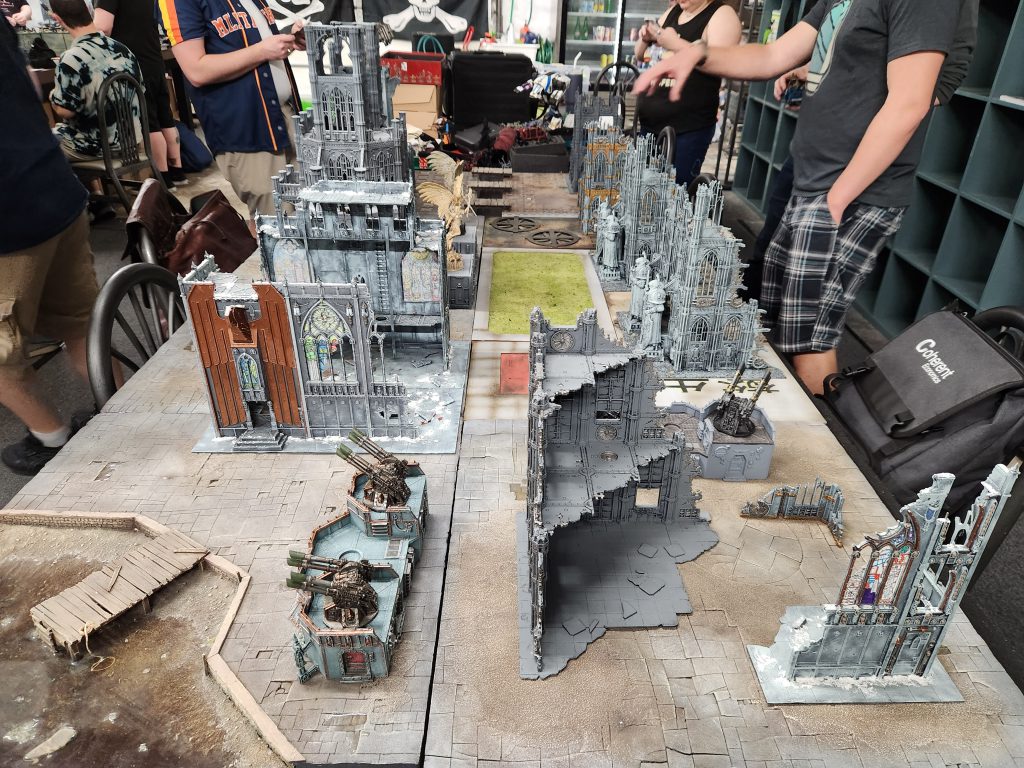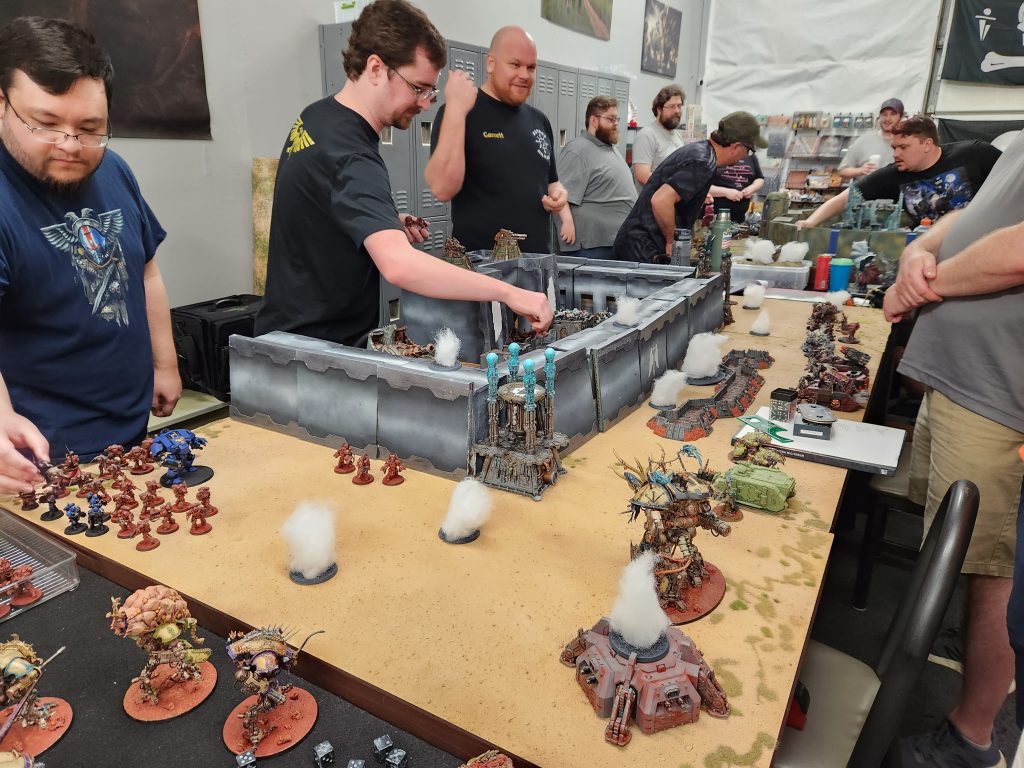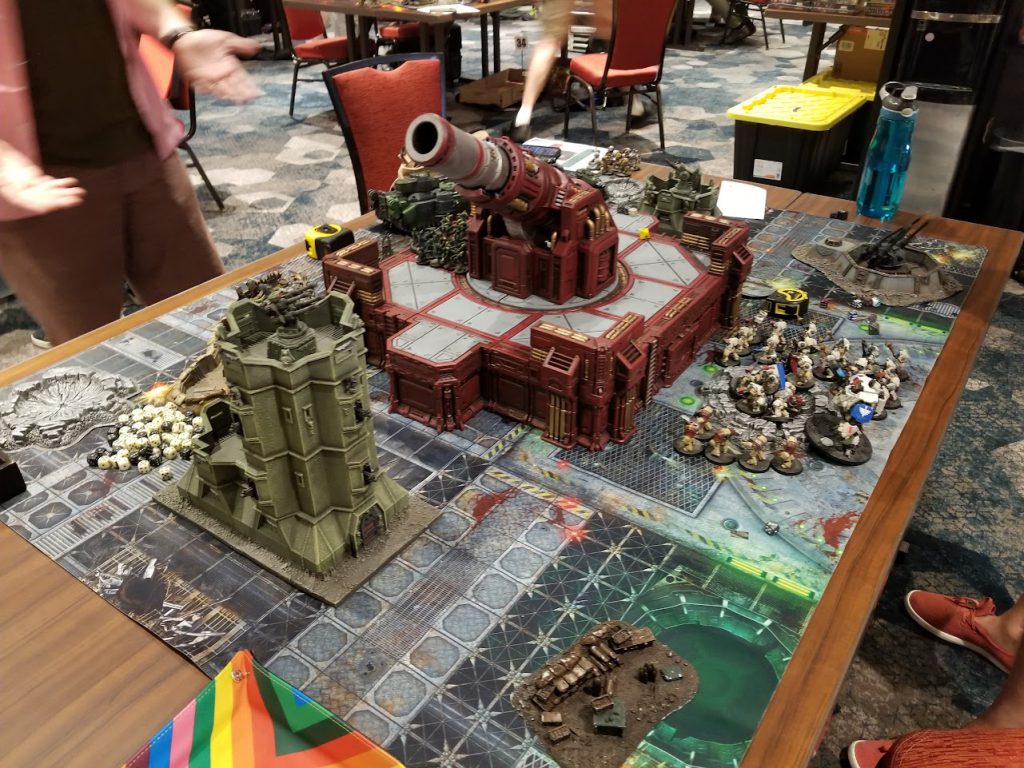In this three-part series of articles we’re looking at how to design, plan, create, and run narrative events. While our examples will be primarily for Warhammer 40,000, we’ll be focusing on lessons that can be applied to any game system.
As I set about planning the Narrative event for this year’s Goonhammer Open (tickets here – there are still some left!), I thought it would be a good time to talk about the planning that goes into a narrative event and how to make a good event.
Narrative events are my favorite events. Both to run and to play in. Few things deliver more on the promise of wargames than a big event with games which are linked together as part of a larger narrative. Whether they’re composed as a self-contained event designed to run over a weekend, kicking off a longer campaign, or acting as a big finale, narrative events are a great way to create unique experiences and when tied to campaigns help ensure the campaign is memorable for players for a long time.
In this three-part series we’ll look at how to plan, create, and run your own narrative events, and dive deep into what makes good narrative events of a variety of sizes, from single games to weekend-long events. In this first part we’ll talk about planning events – what makes a good narrative and what you need to think about in the planning stage. As I go through this I’ll also be talking about the recent Houston Narrative Finale event for Vadinax and the planning and work that went into that event.

Step 1: Determining Your Scope
The first thing you need to do is decided how big your event is going to be. Are you running a one-day event? Full weekend? How many players do you want to have? How involved will they be? Sit down and plot this out. This is also a good time to figure out your teams structure. Generally speaking, you need teams for the event. It makes pairings easier and it helps players feel like they’re working toward a common goal. Also it helps you sort things out if you end up with too many people in one faction or another. That said, how many is an open question. Different numbers of teams provide different benefits and drawbacks:
- Two Teams is the easiest scenario by far – you have your good guys vs. bad guys, attackers vs. defenders, etc. It’s easy to pair people up and figure out what’s going on. That said, this also tends to suck from a 40k/AoS narrative standpoint – you’ll often end up with teams that make little narrative sense, like Drukhari teaming up with Chaos or Tyranids paired with Eldar. That’s not great, and while you can make these work narratively I think they detract from the feeling that you’re making 40k lore as typically two-team setups run Imperium vs. Non-Imperium in 40k.
- Three Teams is more difficult to pull off but lets you introduce a wild card third party, usually “Xenos” into the mix. This can be helpful for showing a group with a varied agenda and preventing balance from tipping too far in one direction or another. This helps with the narrative aspects, but makes pairings a real pain in the ass – you need to put in some extra work to make sure you have the correct player counts to do pairings each round.
- Four (or more) Teams is where my head is currently at for bigger events. In practice I think this is really just two teams for the most part, but lets you break each team into two smaller sub-teams, which can create some interesting tensions. It makes more narrative sense as you can put oddball factions into a separate group, and it allows you to do infighting in a way that makes more sense. Props to Greg “Klobasnek” Narro for showing me the light on this one. You can also do this for more than four teams, in which case I think doing even numbers of smaller sub-teams is the way to go – you still broadly have two “sides” to the conflict, but with opportunities to shape things in weird and interesting ways.
Let’s look at a few of the Narrative events I’ve run and the scope for each, and what that meant for the event.
The 2022 Goonhammer Open
Coming into last year’s GHO I knew I wanted to have more than two teams. And the hardest part about that was just figuring out pairings. This is ultimately how I settled on 24 players – the idea was three eight-player teams, who would play four games against each other team each round. As long as your player counts are a multiple of 6, this is perfectly doable. For a two-day event, somewhere between 5 and 7 rounds is pretty much ideal, with 7 being possible if you really stretch and do some smaller games day one and 5 being the more relaxed schedule option.
The Houston Finale
For the Houston Finale we knew from the outset we were doing a single-day event, mostly to determine the final outcomes of the two local campaigns. I had a general headcount from the two local GMs that looked like something around 30 players including the GH folks attending, and I knew that some would be in and out during the day.
Rather than set firm teams for the event, we decided early on that we wanted to create a series of megabattle tables where players would come in and out over the course of the day. I’ll talk more about this structure later on.
The 2023 Goonhammer Open
For the 2023 Goonhammer Open I want to go with a four-team structure in order to create some interesting inter-team tension and also allow for more of that good narrative freedom. While the teams will broadly be set as “Attackers” and “Defenders, we’re breaking them into two sub-groups each:
- Loyalists – The Imperial forces dedicated to the defense of the planet – in this case, Attos.
- Allies of Convenience – The loosely Imperially-aligned forces whose goals mostly oppose those of the attacking Chaos forces.
- Traitors & Heretics – The Chaos forces mounting a dedicated attack on Attos. Classic bad guys.
- Renegades & Raiders – The mercenaries, pirates, and raiding forces looking to profit from the attack and weaken the Imperium.
We started out with a count of 24 players but now we’re increasing our player count to 32, which gives us 8 players for each team. That’s a good count, but also the upper limit of what I’d want to work with for this event. If we were doing three days I’d consider going up to 36 and having three 6-person subteams per side, or even potentially doing three megafactions, but that’s quickly getting to be too ambitious.
And ultimately, that’s the goal: Don’t get too ambitious. It’s much, much better to execute well on something simple than to overreach and fall short. There are other, better ways to wow people than by overdoing it on your event size.

Step 2: Determining Your Rules
After you have your scale picked out, it’s time to determine what rules you’re going to use. Generally speaking, you don’t need a bunch of fancy rules to run a narrative event. In fact, the fewer you add, the better off you will generally find things to be. When it comes to rules for a narrative event, there are basically three things you need to do:
- Find a way to link games together. You want some common thread between games, and ideally in a way that allows players to feel like those impacts are a result of their actions. Having linked games is a big part of what’s going to separate your event from a competitive event, where games are all standalone.
- Create interesting decisions for the players. Sid Meier is fond of saying that a game is “a series of interesting choices,” and I think that’s accurate enough for our purposes. Your narrative event doesn’t need a lot of rules but it should have some decisions that the players have to make, and the outcomes of those decisions should matter in some way. The easiest decision to have players make is “which battlefield will I fight over?”
- Create interesting missions. Half the fun of narrative is playing asymmetrical missions you wouldn’t see in a competitive event. This doesn’t mean making lost causes or doing things that are wildly unbalanced, but a good amount of your players’ fun will come from trying to win in interesting scenarios. In my opinion a good narrative is one which is also fun for competitive players.
To Crusade or Not to Crusade
You’ll notice I didn’t mention Crusade up there at all. I don’t think it’s super necessary for an event. And while I’m a big fan of the game mode generally, I don’t think it holds up well for shorter events without a lot of modification – and that’s before you consider the 10th edition implementation for Warhammer 40k, which doesn’t really have much faction support right now.
That said, the Houston Narrative Finale used Crusade rules and it was a blast, and that’s in large part to the fact that, while every player had Crusade upgrades on their armies, we didn’t have any XP gains or between-game bookkeeping. Instead, players showed up with the armies they had and played. If it weren’t the finale we’d have considered some rewards at the event’s end, but a lot of the fun came from the fact that we weren’t getting bogged down in the homework during the event.
So while we’ve had fun with Crusade rules in the past, we won’t be working with Crusade rules at the Goonhammer Open Narrative Event this year.
Building a Custom Rules System
Ok, if we’re not doing Crusade, what are we doing? Well, that’s a good question. Our solution at the Houston event was to create four large Megabattle tables, where each table featured 4 to 8 players, each with 500- to 1,000-point chunks of their Orders of Battle. This allowed us to do a few things:
- First, it forced players to use more of their orders of battle and not just the best 5-6 units. This both rewarded players for using more units and also ensured every game wouldn’t just involve a single overpowered character steamrolling everyone.
- Second, it allowed players to experience different tables if they wanted to. How this ended up working was we had one table each to represent the narrative culmination of the Houston and Kingwood campaigns, plus two “challenge” tables – one where Imperial forces were attempting to close some warp rifts on a daemon-infested table, and another where Chaos forces were attempting to capture a Space Marine fortress monastery. Players got to break up their armies and choose where to deploy each round, with players who were hardcore invested in their campaign narratives spending three games on their finale tables while other players who were there for a fun day took on the challenge boards.
- Third, it allowed us to tell longer, more involved stories, moving around on the tables. This is hard to overstate: A regular game of Warhammer 40k does not allow a lot of time for things to happen. Realistically over a five turn game, a unit will do five “things” – and that’s not a lot. Doing three-round megabattles let us tell stories that were basically one game happening over 15 turns, creating room for push and pull and a feeling of accomplishment between games.
With that in mind, we’ll be doing something similar for the 2023 Narrative campaign. Instead of focusing on rounds or missions, we’ll be focusing on a series of battlefields or fronts for the fighting to occur on. Each of these will have a number of slots for player armies, and each slot is 500 points. Players can use multiple slots, but pretty much every table is planned to be at least a 2v2.

Example Table: The orbital defense cannon. One such table will be Outpost Bravo, which holds the massive gun we built for last year’s narrative. The gun itself was a big success, a massive and cool prop for playing a game around, but in execution it was pretty mid, giving players an orbital bombardment they never used. This time around we’re going to focus a bit more on the effect the gun has on the other tables and think more about the long-term story you might tell over it.
When it comes to designing the big gun table, I want to both create some anticipation for the big gun but also let players have fun actually using it. Narratively the gun will be placed high in the mountains, forcing the attackers to fight through some defenses to reach it, and then arriving at the gun they’ll fight over control of it. I’ll need to design a mechanic for control, and determine what that means. I’ll also need to determine how play will change depending on who has control of the gun.
Generally I think giving players an in-game stratagem last time around was a mistake. Rather, I think I want an effect that happens at the start of the game, and gives players a choice. Right now I’m thinking of letting the players do a firestorm bombardment on one table if they control the gun. That’ll happen after deployment, be something both players can plan for, and it’ll be an interesting effect to implement.
Next Time: Designing Battlefields
That wraps up this first look at the rules and scope of a narrative event. Join me next week when I’ll talk about designing and building the battlefields to be used. And in the meantime check out that link and grab a ticket if you’re interested in attending.
Have any questions or feedback? Drop us a note in the comments below or email us at contact@goonhammer.com.



You must be logged in to post a comment.